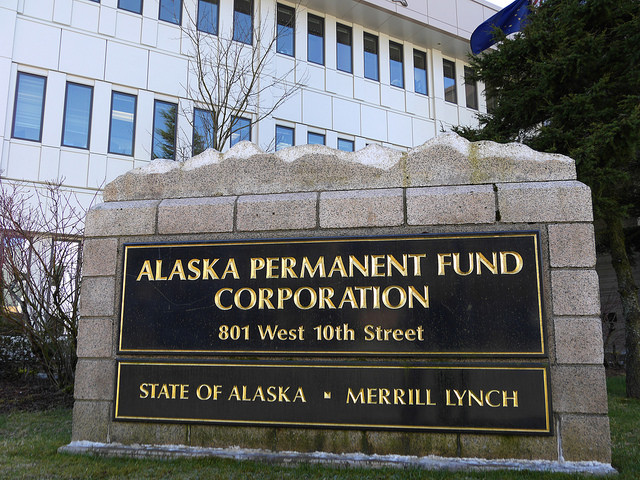
The state agency that manages the Alaska Permanent Fund is again warning that it’s running low on spendable money.
At a meeting in Anchorage on Monday, the managers called on the Legislature to amend the state Constitution to head off what they say is a real risk of a fiscal crisis in the years to come. Already, the Alaska Permanent Fund Corp. expects to start the next fiscal year $600 million short of a planned $1 billion inflation-proofing payment planned for July 2025.
“That’s the first time that we’ve been in this scenario where we’re facing a potential shortfall,” Permanent Fund Corp. Executive Director Deven Mitchell told the Legislative Budget and Audit Committee on Monday.
It’s not that the fund itself is running out of cash — the Permanent Fund had around $80 billion in assets at the end of May. Rather, Mitchell said it’s the structure of the fund that’s the issue.
“So if you shifted the fund structure to one account, then you would instantaneously add $14 billion of available earnings for expenditure,” Mitchell said.
What’s wrong with the structure, according to managers?
Basically, the sheer fact that there are two accounts.
The biggest one, the corpus, has about 85% of the fund’s assets. It’s the principal, so to speak — it’s the portion of state oil and gas and other resource revenue that, along with legislative appropriations, is supposed to, basically, earn interest. And that can’t be spent without a vote of the people.
The other account is called the earnings reserve account. If the Permanent Fund takes some oil money, buys a stock and then later sells it for more than it bought it, the money goes in the earnings reserve account. Interest on bonds and rent on real estate investments is also deposited in the earnings reserve. Most years, part of the earnings reserve is transferred to the corpus, the main account, to protect against inflation.
And that earnings reserve account is important. The state takes 5% of the total fund value out of the earnings reserve every year to fund the government. So that’s where a lot of the money for schools, roads, state troopers and — of course — Permanent Fund dividends comes from. And unlike the corpus, it’s available to spend with a majority vote in the Legislature and the governor’s signature.
For decades, Permanent Fund trustees have pushed to combine the two accounts. Last year, Permanent Fund managers warned the earnings reserve was running out of money. And the warnings are getting louder and louder.
Earlier this year, the Permanent Fund’s trustees released a rare analysis paper showing a 5% chance — 1 in 20 — that the earnings reserve would run short by the middle of 2027 and run out completely in 2028. Fund director Deven Mitchell offered some context
“If I drove to work every day, and every day, and every 20th time I was going to have an accident, I would modify my behavior,” Mitchell told the committee.
How can an $11 billion fund be in danger of running short?
There’s $11 billion in the earnings reserve. That’s about three times the state’s annual 5% drawdown on the fund. So how is it in danger of running out?
The thing is, most of the money in the earnings reserve isn’t spendable. Subtract money set aside for this year’s drawdown, inflation-proofing and unrealized gains, and you’re left with $3.9 billion.
That means there’s $3.9 billion available to spend next year, plus whatever the fund earns from its investments in the next 12 months.
Typically, at the start of every fiscal year on July 1, Permanent Fund managers set aside next year’s 5% drawdown and inflation proofing. But Mitchell said this year, there isn’t enough in the fund today to cover both of those planned transfers.
“For the first time, that $3.9 billion is insufficient,” Mitchell said. “We’re going to be relying on fiscal year 2025, the coming fiscal year’s earnings, to provide for those transfers.”
And that could be risky. Through May, the fund has made about $3.7 billion on its investments over the past 11 months — but as anyone who’s bought a stock can tell you, past performance is no guarantee of future results.
Take what happened in the wake of the dot-com bubble burst in the early 2000s, Mitchell said.
“There were a couple of years where statutory net income was in the $100 to $400 million range, you know, pretty austere, and then in the Great Financial Crisis, there was a year where statutory net income was negative,” Mitchell said. “So if we’re in one of those time frames, that’s kind of, that’s the doomsday scenario.”
Mitchell said there could be ways out of that doomsday scenario. In any case, there would be enough to fund next year’s 5% draw to fund the government — but the fund would fall about $600 million short on planned inflation proofing, Mitchell said.
In response, the Legislature could delay inflation-proofing, or it could also direct managers to sell and rebuy some stocks or bonds to turn those unrealized gains into spendable cash — but that would hurt the overall performance of the fund. And some things, like investments in private businesses or real estate, can’t be easily and quickly sold.
But the best way, managers say, is to amend the state Constitution to combine the two accounts and limit annual drawdowns to 5%. Similar amendments have been proposed in prior years, but none have made it out of the Legislature to a public vote.
Eric Stone covers state government, tracking the Alaska Legislature, state policy and its impact on all Alaskans. Reach him at estone@alaskapublic.org.




